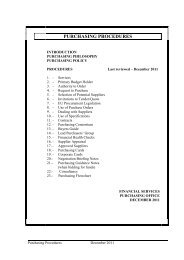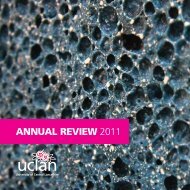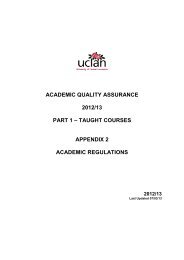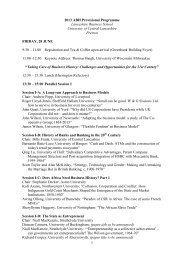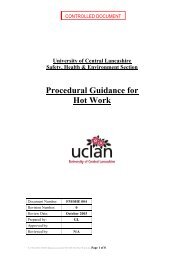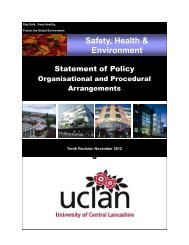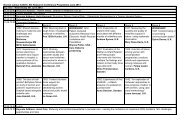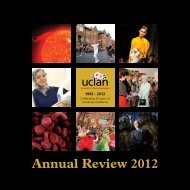Autumn 2011 Issue - University of Central Lancashire
Autumn 2011 Issue - University of Central Lancashire
Autumn 2011 Issue - University of Central Lancashire
You also want an ePaper? Increase the reach of your titles
YUMPU automatically turns print PDFs into web optimized ePapers that Google loves.
Conference Reviews<br />
27<br />
company business models (as they will have<br />
to re-visit things in a different way e.g.<br />
logistics, dealing with supply chain partners;<br />
what happens if a supplier goes out <strong>of</strong><br />
business? etc). These issues are important,<br />
as you need to have a critical mass in the<br />
supply chain. For example, if you design<br />
something that has certain constraints and<br />
technical requirements (to fit in with your<br />
design), and that manufacturer goes out <strong>of</strong><br />
business, it may not always be that easy to<br />
then procure another alternative from a<br />
different manufacturer.<br />
You were also talking about the use <strong>of</strong><br />
virtual reality, so is that about allowing<br />
companies to see how this would fit<br />
together to create a virtual building?<br />
Correct. One <strong>of</strong> the issues now, is that we<br />
have an industry that is steeped in tradition.<br />
It is somewhat parochial, with deep-rooted<br />
values that are embedded in contracts,<br />
relationships, trust, ethics etc. For people to<br />
step out <strong>of</strong> that mindset and into new ways<br />
<strong>of</strong> looking at manufacturing (for example),<br />
new methodologies, new technologies, new<br />
processes etc, then the commercial drivers<br />
and benefits need to be more overt. Some<br />
companies are already doing this with great<br />
success. They are also very good at doing<br />
this, and are now creating competitive<br />
advantage in the marketplace. However, you<br />
need to have commercial tacit knowledge to<br />
take advantage <strong>of</strong> this; and at this present<br />
moment in time within the industry, there<br />
are only a few companies in the UK that<br />
have this. This is one <strong>of</strong> the reasons we are<br />
currently developing a Construction Site VR<br />
Simulator, in order to train construction<br />
pr<strong>of</strong>essionals in this new way <strong>of</strong> working and<br />
thinking. Saying that, the inertia and<br />
momentum is now gathering pace. For<br />
example, I am a Coordinator <strong>of</strong> CIB TG74<br />
looking at “New Production and Business<br />
Models in Construction”. CIB is the<br />
International Council for Research and<br />
Innovation in Building and Construction<br />
(www.cibworld.nl). I am also a member <strong>of</strong><br />
CIB W119 – “Customised Industrial<br />
Construction”. Work undertaken to date has<br />
identified some significant breakthroughs.<br />
One <strong>of</strong> the things we are hoping to do next<br />
is to determine a five-year vision for the<br />
industry, which will include key priority areas.<br />
This will also include an international<br />
research strategy that addresses both theory<br />
and practice - highlighting barriers and<br />
opportunities (cognisant <strong>of</strong> stakeholder<br />
needs, market demand, cultural and societal<br />
influences etc).<br />
Do you consider the new methods <strong>of</strong><br />
construction to have appealing<br />
environmental factors that will<br />
incentivise the use <strong>of</strong> them?<br />
One <strong>of</strong> the benefits <strong>of</strong> adopting new<br />
methodologies and techniques such as this<br />
includes its impact on the environment. This<br />
includes a variety <strong>of</strong> issues, such as a lower<br />
carbon footprint, improved waste control,<br />
fewer defects, more efficient processes,<br />
creating and engendering Corporate Social<br />
Responsibility etc. This means that<br />
companies are now increasingly aware <strong>of</strong><br />
their responsibilities and are actively aligning<br />
these into cogent sustainable building<br />
practices. Therefore, using an approach<br />
such as <strong>of</strong>fsite construction can have a<br />
positive impact on this. For example, the<br />
ability to procure materials, products and<br />
services at a much earlier stage in the<br />
process allows everyone to think about<br />
issues at a very early stage, including: the<br />
pre-vetting <strong>of</strong> suppliers, manufacturers,<br />
contractors etc (regarding their sustainability<br />
credentials), through to looking at aspects<br />
<strong>of</strong> design, functionality, maintenance etc<br />
(over the lifecycle <strong>of</strong> the product).<br />
So this is about making the building<br />
industry more environmentally friendly,<br />
more energy efficient and more<br />
sustainable?<br />
Yes, but again, it is much more than this.<br />
All these benefits are overt and well<br />
documented. Controlled environments such<br />
as factories can help companies achieve<br />
defendable sustainability solutions. However,<br />
what tends to happen now is that the design<br />
<strong>of</strong>ten evolves in parallel with construction to<br />
save time. Using modern methods <strong>of</strong><br />
construction requires people to make<br />
different decisions, and much earlier well in<br />
advance <strong>of</strong> construction. Making those<br />
decisions early means that you can make<br />
parts <strong>of</strong> the product in the factory very<br />
quickly. You therefore know the costs in<br />
advance, know what you are getting, and<br />
everything is very well defined. The downside<br />
is that once you have made these decisions,<br />
you do not have the flexibility to change your<br />
mind as a client that easily, as the products<br />
may be being assembled in multiple factories<br />
for the deliverable dates you have agreed<br />
with them. Changing your mind would<br />
therefore tend to incur additional costs with<br />
cancelled contracts, materials no longer being<br />
needed etc. In this respect, clients within the<br />
industry <strong>of</strong>ten change their minds during the<br />
construction stage for a variety <strong>of</strong> reasons.<br />
So these new methods are as applicable<br />
for small housing projects as for large<br />
construction sites?<br />
Yes, you are right. I have worked with people<br />
on simple commercial dwellings, through to<br />
large-scale projects. The principles are the<br />
same, only the scale and complexity changes.<br />
For example, it is now possible to create such<br />
things as “pods”, which could be a complete<br />
bathroom, kitchen etc which can be slotted<br />
into a building, through to panelised walls<br />
that look exactly like external brickwork – but<br />
much better. The finishes are exemplary; you<br />
would not know for example (even looking<br />
up close) whether panelised walls were brick<br />
or not - you would not know the difference.<br />
Looking at recent show homes, there<br />
was an en-suite bathroom that seemed<br />
poorly designed in terms <strong>of</strong> space utility.<br />
Are we getting to the stage where a<br />
whole bathroom will be designed and<br />
fitted as a unit?<br />
You have highlighted a problem that has<br />
existed for a long time. Traditional house<br />
builders have existing “house types” and<br />
models that they work with. The problem is<br />
construction, and the workmanship used to<br />
create the rooms and spaces needed. If there is<br />
a problem with the construction <strong>of</strong> the space<br />
or quality <strong>of</strong> workmanship, then problems<br />
inevitably arise. This does not tend to happen<br />
with <strong>of</strong>fsite manufacturing, as these two issues<br />
are taken out <strong>of</strong> the equation. You asked if the<br />
whole bathroom could be designed and fitted<br />
as one unit; the simple answer is “yes”.<br />
We have been doing this for some time now.<br />
The clients (you and I) are king here. If you<br />
come to me and tell me what you want, all I<br />
need to know is the specifications you want<br />
(quality and product-wise), along with the<br />
dimensions or constraints that I have to<br />
comply with. This is obviously more expensive<br />
for a one <strong>of</strong>f, but if you are working for one <strong>of</strong><br />
the traditional house builders, then they will<br />
have all the design styles available for you to<br />
choose. In some cases, you will be able to go<br />
online and see your design changes being<br />
made live. Changes that cannot be made will<br />
be for example, ‘greyed out’ as they may<br />
already be in the production process. Virtual<br />
imagery <strong>of</strong> the end products is also available<br />
online. One particular advantage we have here<br />
is the increased use <strong>of</strong> BIM I mentioned earlier.<br />
BIM can provide real-time, on-demand<br />
building information over the Internet. This not<br />
only helps support the design and construction<br />
process, but can also help generate more<br />
environmentally sustainable and energy<br />
efficient buildings.






